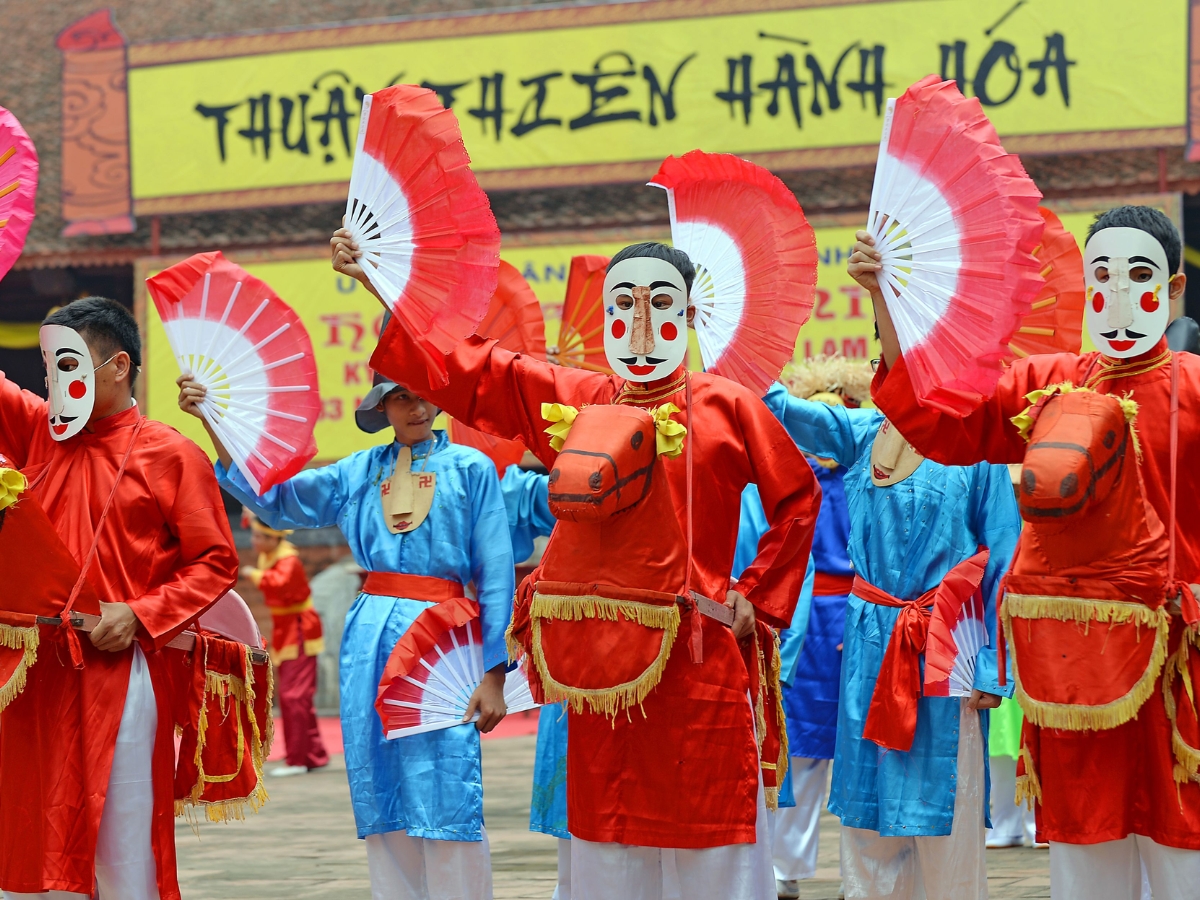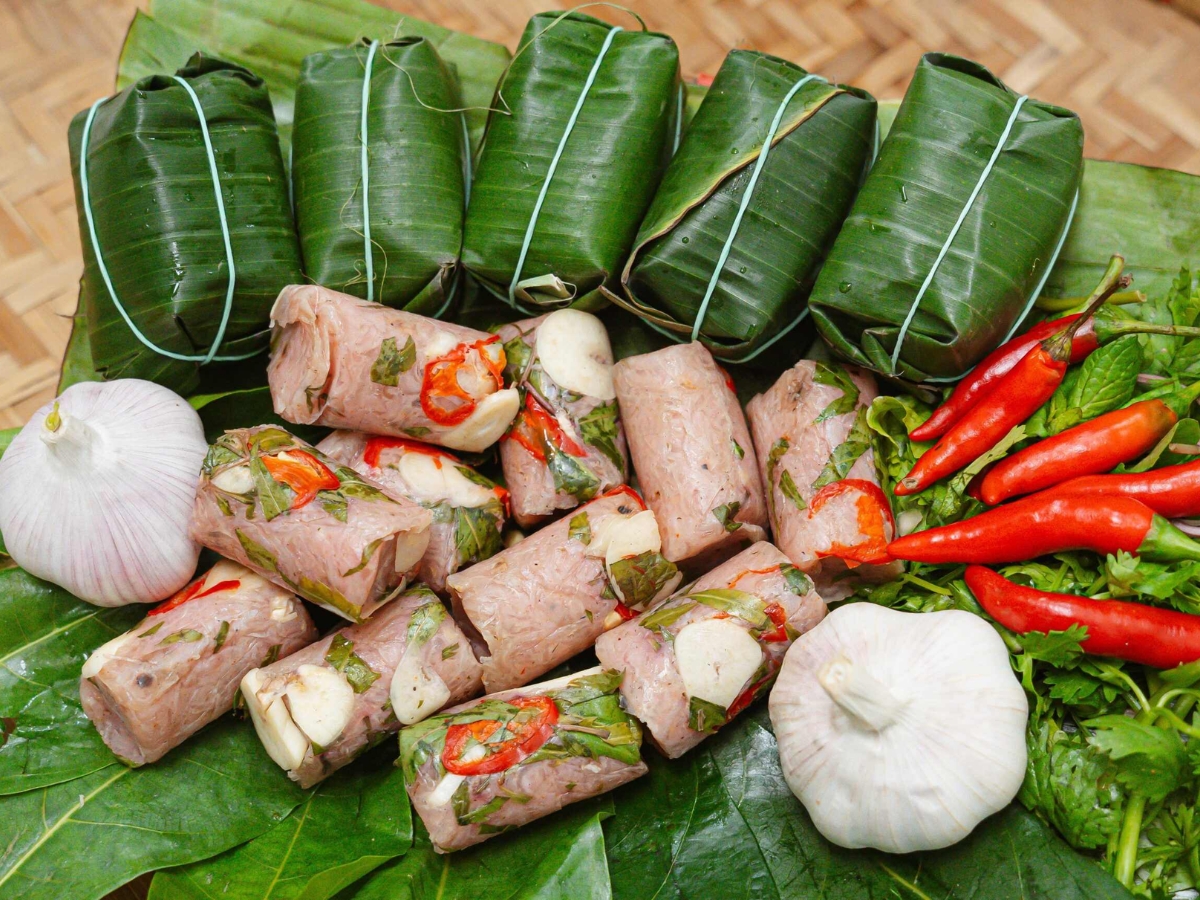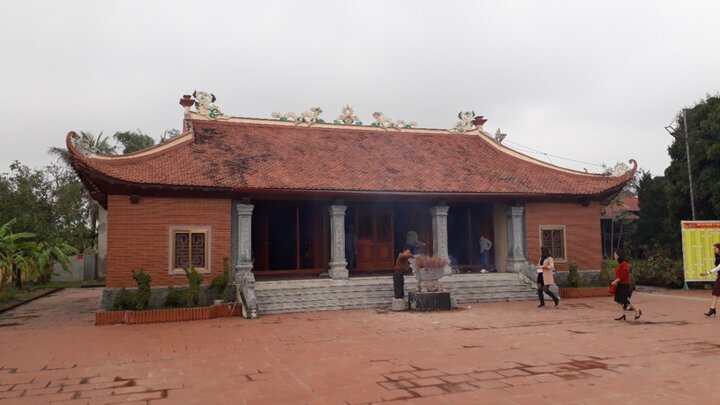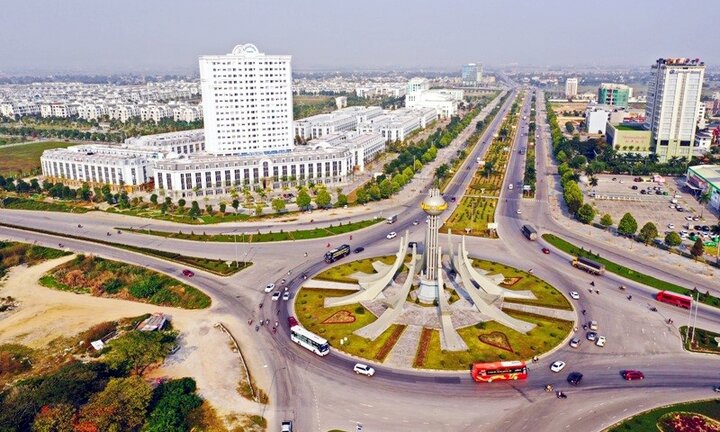1. An overview of Xuan Pha Temple
1.1. Geographical location and unique cultural values of Xuan Pha Temple
Xuan Pha Temple is a structure belonging to the Xuan Pha village communal house, located in Tho Xuan commune, Thanh Hoa province. This place worships two sacred deities: Dai Hai Long Vuong and Queen Duong Thi Nguyet of the Dinh dynasty, who contributed to teaching the Xuan Pha Dance to the villagers, helping to preserve and develop this unique folk performance art for hundreds of years.
Not only a place of community spiritual activities, Xuan Pha Temple is also a typical cultural space. Here, the Xuan Pha village festival takes place annually with special performances of the Xuan Pha Dance.

Xuan Pha Shrine is located in Tho Xuan commune, Thanh Hoa province. (Source: Education and Times Newspaper)
1.2. Formation history and legends associated with Xuan Pha Shrine
According to folk documents, Xuan Pha Shrine dates back to the Dinh dynasty and is associated with the sacred story of King Dinh Bo Linh during the early days of nation building. When advancing into the Ai Chau region to suppress warlord Ngo Xuong Xi, the king sent envoys everywhere to seek the blessings of the people and talented individuals to join forces to fight the invaders and save the country. On their journey, the envoys encountered a great storm and had to take shelter at Xuan Pha Shrine on the banks of the Chu River. That night, the village tutelary god manifested in a dream, revealing the strategy to fight the enemy. After the envoys reported back, King Dinh Bo Linh followed the advice and achieved a resounding victory.
To commemorate the god's merits, the king granted the title of king to the village tutelary god with the title Dai Hai Long Vuong, and ordered Queen Nguyet Nuong to reward the villagers with five mua tro dances to offer to the tutelary god during the village festival. From then on, Xuan Pha Tro was born and is considered a special folk dance, expressing gratitude and reverence towards Dai Hai Long Vuong. Over many centuries, that legend along with the sacred dances have been preserved, becoming a unique cultural symbol associated with Xuan Pha Shrine and the land of Tho Xuan.
2. Why is Xuan Pha Shrine a destination that preserves the soul of Thanh Hoa culture?
Xuan Pha Shrine holds great historical value, serving as a living testament to the era of King Dinh Tien Hoang building and defending the nation. Not only is it associated with the legend of Dai Hai Long Vuong and Queen Nguyet Nuong, but it also embodies the deep connection between the people of Thanh Hoa and their patriotic tradition, martial spirit, and gratitude towards ancestors. Every architectural detail and every festival ritual clearly reflects the cultural identity and pride of the people of Thanh Hoa.
Besides its historical significance, Xuan Pha Shrine is also a center for preserving and promoting traditional folk art. It is the cradle nurturing Xuan Pha Tro, a rare form of folk performance recognized as a national intangible cultural heritage. Annually, the festival at the shrine is not only an occasion to commemorate the merits of the deities but also a space for cultural exchange, where the community collectively preserves, teaches, and disseminates the essence of traditional art. This combination of historical, cultural, and folk art elements makes Xuan Pha Shrine a representative destination that fully preserves the soul of Thanh Hoa culture.

Xuan Pha Communal House is the cradle nurturing the Xuan Pha Dance. (Source: thoxuan.vn)
3. Architectural and landscape characteristics of Xuan Pha Communal House
Xuan Pha Communal House is an ancient architectural work imbued with the traditional style of the Northern Delta region, both majestic and close to the Thanh Hoa countryside landscape. The structure has a scale including a five-bay front hall, a three-bay main hall, two symmetrical left and right wings, along with a worship hall and a three-tiered double-eaved gatehouse. Among these, the three-tiered gatehouse architecture is a prominent highlight, creating a solemn and ancient impression for visitors entering the spiritual space of Xuan Pha Communal House.
Through many historical upheavals, especially during the land reform period of 1953 – 1954, the structure was severely damaged. In 2011, the local government and people joined hands to restore Xuan Pha Communal House on its old foundation, preserving the traditional architectural style and restoring the exquisite wood carving details. This reconstruction not only signifies the restoration of the relic but also expresses gratitude to the deities worshipped, while preserving the cultural and spiritual space for the community. Today, Xuan Pha Communal House is not only a sacred pilgrimage site but also a symbol of the solidarity and cultural heritage preservation consciousness of the people of Thanh Hoa.
4. Understanding the rituals and experiential activities at the Xuan Pha Communal House festival
4.1. Festival schedule and main activities
The Xuan Pha festival is held annually from the 10th to the 12th day of the second lunar month at the Xuan Pha Communal House relic site. This is one of the typical traditional village festivals of Tho Xuan commune, which has existed for a very long time and is considered an indispensable spiritual and cultural activity for the local people.
The festival is held to commemorate the merits of the village tutelary god, Dai Hai Long Vuong Hoang Lang General, who helped King Dinh Tien Hoang quell the rebellion of the 12 Warlords, bringing peace to the country. During the three days of the festival, a festive atmosphere spreads throughout the village with a series of traditional activities such as the ceremony honoring past scholars, processions of texts, royal decrees, and sacred amulets, worship ceremonies for the tutelary god, the 'keo hoi' ritual, and tug-of-war competitions between cultural villages.
Notably, the festival's 'hoi' (festive) part is a prominent highlight with the performance of the Xuan Pha Dance by six villages in the region. The dances are highly artistic and contain profound historical value, demonstrating the spirit of solidarity, friendship, and the Vietnamese people's aspiration for peace. With the harmonious combination of solemn rituals and lively festivities, the Xuan Pha Communal House festival is not only an occasion to commemorate the merits of ancestors but also a place to preserve and promote the unique folk cultural identity of Thanh Hoa, contributing to the preservation of the nation's precious spiritual heritage.

Performance of Tro Xuan Pha dance among villages in the region. (Source: Thanh Hoa Newspaper)
4.2. Participate in the Tro Xuan Pha experience
Visiting the Xuan Pha communal house festival, tourists will have the opportunity to admire and experience Tro Xuan Pha, a unique folk performance art form found nowhere else in Vietnam. The most prominent part of the performance is the dance of the Five Kingdoms offering tribute, consisting of five dances named Chiem Thanh, Ai Lao, Ngo Quoc, Hoa Lang, and Luc Hon Nhung. Each dance tells a vivid story, recreating the image of ancient kingdoms and tribes coming to offer tribute to King Dinh Tien Hoang, embodying the spirit of peace, friendship, and the aspiration for tranquility of the Vietnamese people.
The artistic value of Tro Xuan Pha lies in the exquisite combination of music, costumes, dance movements, and theatrical elements, creating an atmosphere that is both solemn and lively. Local artisans are the soul of the festival. They not only preserve every drumbeat and lyric but also pass on to the younger generation a love for their homeland's heritage.
Immersing themselves in the festival atmosphere, visitors will feel the vibrant vitality of Tro Xuan Pha, where folk art is not only performed but also permeates the community's spiritual life. This is a testament to the enduring culture of the Thanh Hoa region, where people and heritage harmonize through generations.
5. Itinerary for visiting Xuan Pha communal house and nearby attractions
5.1. 1-day itinerary visiting Xuan Pha communal house and enjoying local cuisine
A day exploring Xuan Pha communal house will offer visitors a complete experience of the culture, beliefs, and life of the people in the Thanh Hoa region. In the morning, visitors can attend the solemn ceremony at Xuan Pha communal house, immersing themselves in the sacred atmosphere of the procession, sacrificial rites, and incense offering to commemorate the village tutelary deity. Afterwards, spend time exploring the relic to learn about its architecture and listen to the stories of Dai Hai Long Vuong and Queen Nguyet Nuong.
At noon, visitors can enjoy local cuisine with dishes rich in the flavors of the Tho Xuan region, such as Thanh Hoa fermented pork roll, steamed rice rolls, Che lam, bitter leaf soup, or grilled free-range chicken with lemongrass. The afternoon is the ideal time to watch Tro Xuan Pha, enjoy the lively, colorful folk dances, and interact with local artisans. This experience not only brings joy but also helps visitors gain a deeper understanding of the spiritual and cultural life of the local people.

Enjoy the famous Thanh Hoa fermented pork roll specialty. (Source: Collected)
5.2. Suggestions for must-visit tourist attractions when visiting Xuan Pha Communal House
After exploring Xuan Pha Communal House, visitors can continue their journey to other famous tourist destinations in Thanh Hoa. Sam Son Sea Square is a great choice to immerse yourself in the vibrant atmosphere, admire the brilliant sunset, and participate in exciting festivals and entertainment activities. For those who love spiritual culture, the area can be visited. Additionally, history enthusiasts can visit the Lam Kinh historical site, which is associated with the Later Le Dynasty, to learn more about its cultural values and ancient architectural works.
Besides, Thanh Hoa is currently commencing the construction of the Am Tien Legend in the Nua mountain area, with the orientation to develop this place into a large-scale spiritual tourism center in the future. This place promises to offer a new spiritual destination, contributing to enriching the journey of exploring the cultural and historical heritage of the Thanh Hoa land.
The combination of Xuan Pha Communal House and other destinations helps make the Thanh Hoa tourism journey richer, more multi-dimensional, and more meaningful. Visitors can both worship and learn about history, while enjoying the natural beauty and unique culture of this sacred land.
Xuan Pha Communal House is not only an ancient cultural relic, but also a place that preserves the soul and essence of the Thanh Hoa people through generations. Each festival, each Trò Xuân Phả dance, all contain pride, gratitude, and a sense of preserving national traditions. Amidst modern life, when stopping here, you will feel the harmony between the past and the present, between culture and spirituality. Once, come to Tho Xuan, visit Xuan Pha Communal House to listen to the resounding festival drums, admire the traditional dances, and fully feel the soul of the proud and affectionate Thanh Hoa land.







